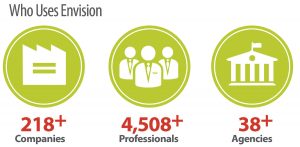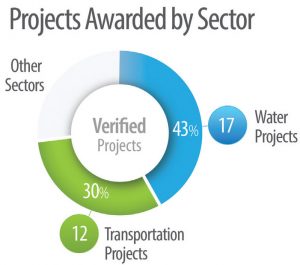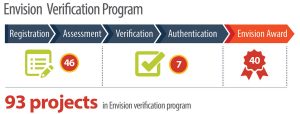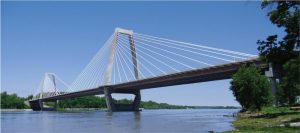A modern challenge of the engineering profession is to account for the unintended consequences and life cycle costs from impacts of infrastructure on the environment, society, and economy. While this challenge has been realized on a global scale for more than half a century, tools for design professionals in the United States to systematically address this challenge were not developed until the formation of the Leadership in Energy and Environmental Design (LEED) by the United States Green Building Council. LEED, while bringing the building industry forward, did not directly address sustainability of nonbuilding civil infrastructure. However, Envision, developed by the Institute for Sustainable Infrastructure (ISI), did.
Envision acts as an overlay to the planning and design process. Used early in the initial planning phase, it provides insight on stakeholder engagement, optimizing project benefits, and setting up performance goals to maximize the sustainability of the project. In later project phases, it is used as a reminder to follow through on sustainable performance goals within the specifications.
This article discusses Envision’s role in the structural engineering profession and how it is used as a complementary project management tool.
Envision as an Industry Standard

Companies, agencies, and individuals are showing their commitment to sustainable infrastructure by applying Envision in their communities and becoming members of ISI.
Envision is an internationally recognized sustainability rating tool developed by the ISI and the Zofnass Program for Sustainable Infrastructure at the Harvard University Graduate School of Design. ISI was founded by three professional organizations, the American Council of Engineering Companies, American Public Works Association, and American Society of Civil Engineers.
After collaborating with agencies, municipalities, universities, consultants, and other existing rating systems, like the United States Green Building Council, the first version of Envision was introduced in July 2011. Later that year, ISI and the Zofnass Program combined their systems to introduce the second version of Envision in February 2012. Envision was originally developed for use in the United States and Canada but has been applied worldwide. In 2012, the Envision Sustainability Professionals (ENV SPs) credential was developed to show proficiency in using the system. Also in 2012, project teams could register for third-party verification to receive Envision certification. Currently, over 4,500 professionals in Africa, Asia, Australia, Europe, North America, and South America have attained their ENV SPs.
Although the Envision guidance manual and online rating tools are available at no cost, project teams are taking the next step to verify that their sustainable project performance goals are meeting the sustainability criteria of Envision. Having projects vetted through a third-party verification process helps demonstrate the sustainability commitments made by the project team while addressing the concerns of their communities. Using this transparent sustainability rating tool has been a great way to communicate and highlight the sustainable infrastructure being implemented.

Envision can be used for all types of infrastructure, but has been implemented the most in water or transportation related projects.
The majority of projects that have been verified under Envision have been transportation or water focused. As of October, 40 projects have been verified which has contributed to 9.9 billion dollars of sustainable infrastructure.
Envision’s Purpose
As suggested by the ISI, the purpose of Envision is to “to foster a dramatic and necessary improvement in the performance and resiliency of our physical infrastructure across the full spectrum of sustainability.” Specifically, it is a guidance tool for our industry to make informed decisions and provides sustainability metrics that can be applied to all types of infrastructure. The tools and guidelines are available through the ISI’s website, www.sustainableinfrastructure.org.
The Envision guidance manual has 60 sustainability criteria that are used to evaluate project development. The criteria are organized into five categories:
- Quality of Life (QL) – Addresses the quality of life of the surrounding communities, looking at the individual and community as a whole.
- Leadership (LD) – Ensures that leadership and people are in place to plan, develop, and monitor the project.
- Resource Allocation (RA) – Reduces the amount of materials, energy, and water needed for a project, while also looking at the quality and source of these resources.
- Natural World (NW) – Looks at how the project integrates and affects the surrounding natural environment’s land, water, and biodiversity.
- Climate and Risk (CR) – Plans and prepares for climate change resilience and emissions reduction.
An important aspect of Envision is that their credits are interdependent. This allows the project team to maximize project benefits and evaluate competing ideas on how to achieve those goals. It also forces the issues of a holistic approach to maximize sustainability. For example, a project team may want a high level of achievement on credit RA1.3 – Use Recycled Materials and choose a building material with a high-recycled content. However, that same material may not be very durable and may require frequent maintenance or replacement. This would impact the level of achievement from RA1.1 – Reduce Net Embodied Energy and LD3.3 – Extend Useful Life. The performance of a project evaluated using Envision does not hinge on one action or criteria; rather its goal is to consider the balance of all criteria to maximize sustainable performance (i.e., a triple-bottom-line approach).
Using Envision

Envision’s guidance manual and online tools are free to use. However, 93 projects have decided to verify.
Envision is meant to be used early in the planning and scoping phases of a project and helps identify goals. While it covers the entire design phase, the biggest impact on a project is solidified at the beginning. For example, it is useful in making the decision on whether a bridge, a tunnel, or a ferry system is the best project for a particular water crossing. Several Envision credits will be impacted depending on the project selected; however, a credit that would achieve the same score is LD1.4 – Provide for Stakeholder Involvement. The best water crossing will require stakeholder engagement. Early in the project is the most appropriate time to identify key stakeholders and implement an engagement plan. Also, it is the most opportune time to determine how the project’s impact on the climate will be accounted for and mitigated. Envision helps identify and communicate these issues to all project team members. Engineers need to be involved in these early project phases to help evaluate alternatives and potential risks.
Envision provides project managers with tools, like the online checklist and the guidance manual, that can be used to help scope projects, provide items for discussion, and highlight areas of improvement and success in each project. Using the online checklist, project managers will go through 55 questions in the five categories, asking whether the project is meeting specific sustainability metrics.
The Envision checklist is used at the beginning of a project to help identify project goals and scope. The series of questions in the checklist are tied to the Envision criteria to be used as references in later project phases. The questions are “yes or no” and relatively easy to understand. The checklist does not provide a rating.
The next step in the process is to turn the goals and scope identified by the checklist into criteria and actions. At this stage, the Envision guidance manual can be used to identify the degree to which each project goal is achieved. Various project alternatives can also be evaluated.
It is never too late to use Envision during the design of a project. Although goals have been set and many decisions have been made – such as the type of project, location, and an environmental impact study (EIS) has been conducted – there are still opportunities to improve sustainability. When a structural design team is working on the final design, they can still review the project for items that were missed in the EIS and suggest alternatives to the client that improve sustainability without impacting the project’s budget or schedule. This is highlighted through the development of specifications.
The Unified Facilities Guide Specifications (UFGS), used on military construction projects, have incorporated sustainability provisions that are customized by the engineer. Specification 03 30 00 for Cast-in-Place concrete, for instance, includes many conditions that can have an impact on the material’s embodied energy. To maximize the level of achievement in credit RA1.1 – Reduce Embodied Energy and RA 1.3 – Use Recycled Materials, replace energy intensive cement with high fly ash or blast furnace slag content. However, to utilize a high fly ash or slag content, the engineer should specify a 56- or 90-day concrete strength, due to the slower strength gain of those materials. Additionally, the recycled content of the formwork and other construction materials could be specified to reduce the energy intensity.
A simple but effective action is including Envision in the basis of design (BOD) along with specific credits and measures taken by the project team. Including Envision with sustainability goals in the BOD opens communication between team members which increases opportunities to increase sustainable performance. By being proactive, Envision criteria can be used to communicate benefits and discuss changes to the project. While the impact may be small on the current project, the client and other project team members have been introduced to Envision and may then implement it earlier on future infrastructure projects.
Envision is useful as a tool to remind the engineer of sustainable actions that are not currently part of their normal routine, such as the items described in credit CR 2.1 – Assess Climate Threat for instance. Many structural engineers working on coastal projects are familiar with the concept of rising sea-levels; what is not well understood, though, is how to quantify the amount of sea-level rise. The United States Army Corp of Engineers has developed sea-level rise predictions based a climate models and various climate forcing events (www.corpsclimate.us). A good exercise for all coastal projects is to use the models to perform a boundary analysis for impacts to the project from a low to high probability of sea-level rise over the life of the project. While designing the project to accommodate the maximum level of predicted sea-level rise may be impractical, it gives the client an idea of the potential impacts and an opportunity to build-in a level of adaptability.
As structural engineers, we are familiar with factors of safety as a part of our design calculations because of the uncertainty in operational and nonstationary environmental loading over time. Sensitivity analyses are often conducted to determine a structure’s response to varying soil conditions, boundary conditions, load configurations, and the like. The ability to sustain loading that develops over an extended period of time, such as from sea-level rise, storm surge, and storm intensity, as well as durability from short term loadings, such as earthquakes and tsunamis, are all considered in Envision. Both could have significant impacts to the project and the system of which it is a part.
The Bottom Line
Structural engineers play a vital role in delivering safe, reliable, durable, and adaptable infrastructure for society. While doing so, we need to take a holistic approach that looks at more than just our role, but rather how our decisions affect other project elements, affect the existing infrastructure system, and how the project, within in the infrastructure system, will affect the community when it is complete. Sustainability is not easy to quantify but, with tools like Envision, we can better identify, communicate, and implement sustainable project goals.
Use of Envision for the Ohio River Bridges – East End Crossing (ORB EEC)

Ohio River Bridges – East End Crossing (ORB EEC): The tall, elegant, diamond-shaped towers were limited to 300 feet in height to reduce visual impact on the historical setting. The design also evokes the region’s historic lime kilns. Both of these aspects of the design contributed to achieving Envision QL Credit: Preserve Views and Local Character. Photo courtesy of Parsons.
During project planning of a major P3 transportation project, the ORB EEC Technical Manager, Parsons’ Steven Nicaise, P.E., Louisville, KY, led the team that developed the sustainability goals, objectives, and performance measures with client stakeholders such as Indiana DOT (INDOT) and the owner, the Indiana Finance Authority (IFA). This led to the requirement for a Sustainability Management Plan in the Technical Provisions.
Resilience and durability were included in the contractual requirements through the Accident and Terrorist Vulnerability Assessment and multiple Corrosion Protection Plans and Durability Plans. Therefore, the project’s overall technical and sustainability requirements were well-aligned with Envision credit guidelines.
The following credits were influenced by structural engineering, with the most significant impacts in the Quality of Life (QL), Leadership (LD), and Climate and Risk (CR) categories:
QL 2.1 Enhance Public Health and Safety
QL 2.2 Minimize Noise and Vibration
QL 3.2 Preserve Views and Local Character
QL 3.3 Enhance Public Space
LD 1.3 Foster Collaboration and Teamwork
LD 2.1 Pursue By-Product Synergy Opportunities
LD 3.1 Plan Long-Term Monitoring and Maintenance
LD 3.3 Extend Useful Life
RA 1.4 Use Regional Materials
CR 2.2 Avoid Traps and Vulnerabilities
CR 2.3 Prepare for Long Term Adaptability
CR 2.4 Prepare for Short-Term Hazards
CR 2.5 Manage Heat Island Effects
Corrosion Protection Plans (LD 3.1, LD 3.3, CR 2.2, CR 2.3): This plan addressed detailed material selection – such as the use of weathering steel for the superstructure, performance-based concrete mix designs based on exposures, and maintenance needs for components to extend useful service life.
Structural Health Monitoring System (LD 3.1, LD 3.3, and CR 2.3): A risk assessment was performed and a corresponding system selected to evaluate weather conditions and structural forces and movements along the structure.
Accident and Terrorist Vulnerability Assessment (CR 2.4): A risk assessment was performed to determine the magnitude of risk and the protective measures available to mitigate risks.
Through these and other measures, a Platinum award was achieved for the ORB EEC project.
Envision adds benefit to the infrastructure we build for society, and a knowledgeable, multidisciplinary team is essential to optimize a project’s sustainability performance. Structural engineers contribute by considering procurement distances, material embodied energy, recycled content, protection strategies, improved durability, adaptability and resilience, end-of-life disassembly and disposal, and other factors that influence the life cycle environmental performance of the structure. Familiarity with Envision credits can inform early design configuration, material choice, and structural detailing decisions. In this way, structural engineers can contribute to the ability of our infrastructure to withstand potential future risks and vulnerabilities associated with climate change.▪
